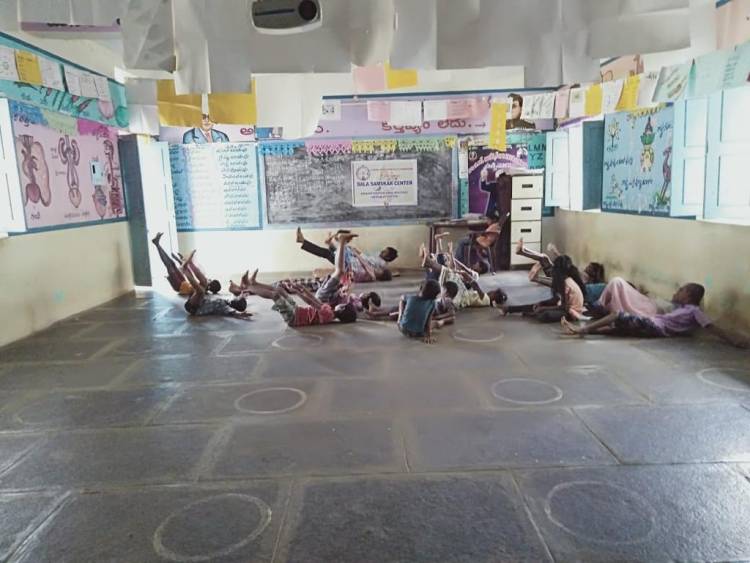[GHHF] Bala Samskar Kendras – Students visited Hindu Temple, witnessed Puja, listened Mantra chanting, learned about Murthy worship and enjoyed Prasadam.
 "Hinduism has proven much more open than any other religion to new ideas, scientific thought, and social experimentation. Many concepts like reincarnation, meditation, yoga and others have found worldwide acceptance. It would not be surprising to find Hinduism the dominant religion of the twenty-first century.” Prof Klaus Klostermaier
"Hinduism has proven much more open than any other religion to new ideas, scientific thought, and social experimentation. Many concepts like reincarnation, meditation, yoga and others have found worldwide acceptance. It would not be surprising to find Hinduism the dominant religion of the twenty-first century.” Prof Klaus Klostermaier
Global Hindu Heritage Foundation is very happy to inform that our Bala Samskar students went to a Hindu Temple and witnessed Abhishekam and heard mantras chanted during Abhishekam.
For thousands of years Hindu temples have been constructed, allowing people to immerse themselves in an atmosphere where they can worship a particular form of God, gather with other devotees, and become more connected to the Absolute.
Though most Hindu temples are usually open to the public, it is important to enter each one with the understanding that it is a sacred space. Being conscious of certain etiquettes can help one navigate the hallowed grounds of a temple respectfully.
Before entering a temple, it is generally recommended to be clean and modestly dressed. For both men and women, this generally means not wearing shorts and keeping the shoulders covered. Traditions can vary, however, from temple to temple. Some place a greater emphasis on dressing simply, requiring men to be shirtless and to wear only unsewn cloth.
Temples are like homes of the Gods. When you enter, you are a guest in that home. Before entering a temple everyone is required to remove shoes. Sometimes this is entirely outside the temple complex and other times at a designated space inside the complex, but before entering the temple proper. If it’s not obvious where to do so (racks for shoes, informational signs) just ask where to leave your shoes. Removing dirty shoes makes you cleaner, and is a sign of respect for the proprietor whose house you are about to spend time in.
Why do we worship the deities through repeated abhisheka, Aradhana (homage) etc.? The fact that the dry stone has high electrical resistance and very little conductivity shows that repeated abhisheka, Aradhana, etc., are essential to maintain the electrical charges in the sanctum-sanctorum. The yantras or Sri-chakras kept under the idol act as capacitors of electrical charges.
Why do we use only certain selected leaves and fruits for pooja offering? The neem leaf has high electrical conductivity and is used by the priests of Kali temples. Lime fruit offers little resistance to electrical current and so is a good conductor. For the same reason, mango leaves, and Tulsi are used during festival times. Ordinary grass offers very high resistance to electrical current and so is not offered for pooja.
Thus we find that repeated abhisheka, Archana, etc., create negative ions inside the sanctum-sanctorum. These negative ions are essential to fix the oxygen with hemoglobin. It has been proved that animals die in an atmosphere deprived of negative ions. These negative ions are found more on the seashore, near waterfalls and on hill stations which are considered as health resorts. This explains why our forefathers selected the seashores, tops of hills, and areas near waterfalls for the construction of temples, for example, Tiruchendur, Rameswaram and Kanyakumari are on the seashore, Palani and Tirupati are on top of hills and Courtallam is a temple near waterfalls.
The meaning and significance a Hindu Temple
A Hindu temple is sacred field (kshetra) in which God is established, just as he is established in the field of Nature. It is a miniature universe, the playground of God’s leela where devotees have an opportunity to envision him, interact with him and serve him with love and devotion. It is a field of human creation in the creation of God, which reflects the essential beliefs, values, way of life and ideals of Hindu Dharma both in its form and function. Symbolically it represents alike the cosmos and the human body, as described in the following verse:
Sikharam sheershamithyaahuh garbhageham galam tathaa. Mantamapam kukshirithyahuh praakaaram jaanujanghayoh. Gopuram paadamithyaahuh dhvajo jeevassamuchyathe.
It is said that the Sikhara is the deity’s head, the sanctum is his neck, the mantapa is the stomach, the prakara constitutes his legs, the gopuram represents his feet, and the dhwaja the seat of his prana.
The temple building represents the body of the deity or the materiality or Nature (Prakriti), while the deity in the sanctum of the temple represents its soul or the Supreme Self. The other deities, associate divinities, emanations, and manifestations, represent the pantheon. The tall gopurams which rise from the ground up represent the aspiring nature of human devotion and the connecting link between the earth and the heaven and between humans and gods. The gateway through which you enter is the gateway to heaven. Since thousands of devotees congregate at the temples and unite their minds in the contemplation of God, the temples are also vast energy centers. By contemplating upon deities, we also create their replicas in our subtle words and give them a life of their own.
DONATIONS
PayPal Method: To donate visit our website: savetemples.org. Click on the Donate button, then press the Purpose category, and select the General Donation category.
By Check: Or you can send a check payable to: GHHF. It is tax-deductible.
By Zelle: ghhfusaorg@gmail.com
By Rupees, please contact us by either phone or email.
For more information, call Prakasarao V Velagapudi – 601-918-7111; Email: ghhfusaorg@gmail.com




















 Urgent support needed for Bangladesh Hindus
Urgent support needed for Bangladesh Hindus 







